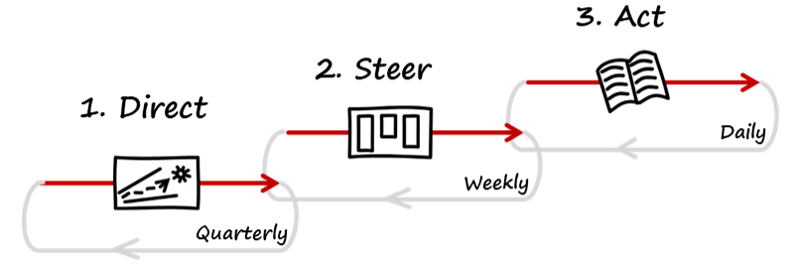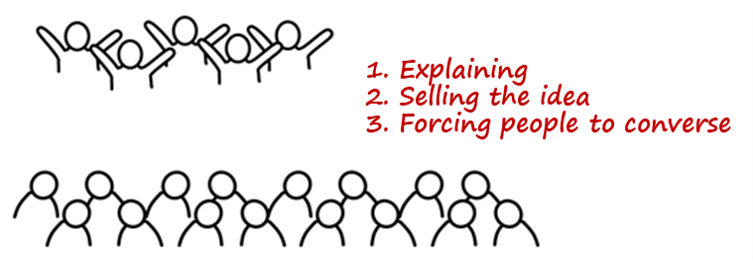
The Biggest Mistakes in the Strategy Process — Mistake 1: Not Involving People | 4.01
Markus Westerlund
Share this blog
This is the first blog of three to address the biggest mistakes that can happen during a strategy process. Today, I will be introducing the cardinal mistake in a strategy process, the lack of involvement.

Three loops
This model that describes the strategy process consists of three rotating loops. The management directs the company in the first loop, which means strategic decisions, and implementation follow-up takes place quarterly. The second loop is where everyday leadership activities take place. People identify sub-goals, and implementation follow-up takes place weekly. People lead themselves for the most part during this loop. The third loop consists of everyday operative work, and it constantly rotates in every company.
The deciding skill is how to connect these three loops. But when trying to link them together, various types of problems may arise.
Mistake 1: Lack of involvement
The first great mistake and the cardinal mistake in a strategy process is to not. involve people in the thinking process. People can be efficiently involved today because technology makes this very easy, convenient, and efficient. The traditional way would be far more expensive, so it is not common to invite the whole organization to participate. The old way is outdated, and you should seriously consider updating your assumptions about what it means to involve people in the strategy process. The default answer is that you should include everyone because it is possible to do it very efficiently.
Lack of exitement

The staff lacks excitement because the management hasn’t involved them in the strategy process.
In the old world, the management sits down in a conference room and thinks about the company strategy. After a long and arduous negotiation, they finally decide the strategy and are excited that it is ready. A press conference is held, which the staff is happy to attend. Even so, in the end, the employees can have unanswered questions. They can also be confused about what it all means for them in practice.
If you desire to hold a formal briefing for the staff, you encounter a few problems:

When the management doesn’t involve the staff they will have to explain the strategy, sell the idea, and force people to talk about their idea.
You need to explain to people what the strategy is to sell them the idea. They either will or won’t buy what you present. How can you get them to understand? One CEO came up with the worst words in Finnish that I have ever heard — Keskusteluttaminen. In Finnish, it means something like forcing people to converse. To put it bluntly: “Make those idiots converse so that they would finally understand what’s going on.”
STOP!

Stop! Don’t do it like how I explained above. Involve your staff!
Instead, see your strategy process as a genuinely fantastic opportunity to have people think genuinely together!
Let's work genuinely together!

Let’s work genuinely together! Involve all staff and reap the rewards. Everybody wins.
First, a one-hour kickoff takes place with everybody present. People are all asked questions about topics like growth and problematic issues. Next, come the workshops. Thanks to technology, workshops can be held with a larger group. People get asked to volunteer themselves.
After the workshops, the partly done, unfinished, strategy gets previewed to the entire staff, and they have the opportunity to give feedback and share their opinions. At the very end, the organization holds the finalization workshops, and the final output gets shown to the entire staff.
Thanks to the fact that people can take part from the very beginning, minimal persuasion needs to occur. Everybody had the opportunity to steer the process. Strategy implementation began during the kickoff meeting. By the time the strategy process completes, somebody in the organization may already have started using some ideas in practice.
Avoid the cardinal mistake in your strategy process!
Recent Posts
Stradigo
Stradigo is a brand owned by Rdigo Oy (Business-ID: 2120844-1).
Learn more from our Imprint.
Rdigo Oy is registered in Finland as a Limited company. We are a strategy consultancy located in the Helsinki capital region.
We’ve been in business since 2007. The company name comes from the latin word Redigo, meaning both ‘I shape’ & ‘I renew’.
Stradigo combines the word strategy with Rdigo.